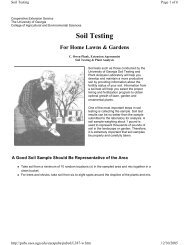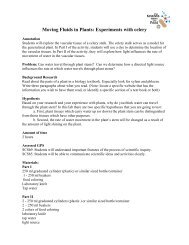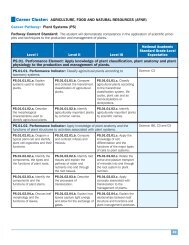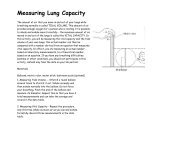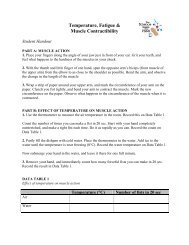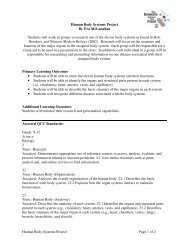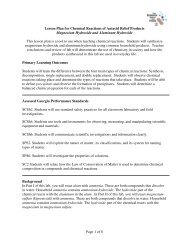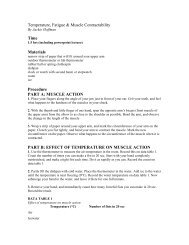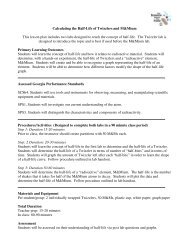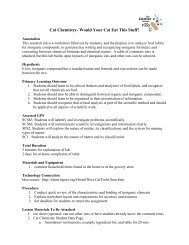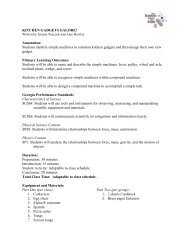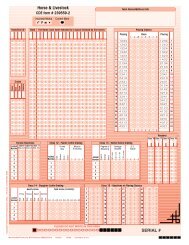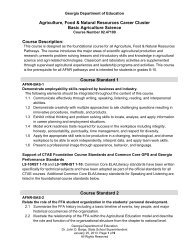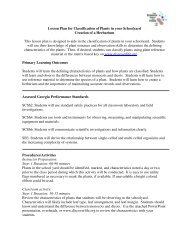Introduction to Toxicology Lesson Plan This lesson plan serves as ...
Introduction to Toxicology Lesson Plan This lesson plan serves as ...
Introduction to Toxicology Lesson Plan This lesson plan serves as ...
Create successful ePaper yourself
Turn your PDF publications into a flip-book with our unique Google optimized e-Paper software.
<strong>Introduction</strong> <strong>to</strong> <strong>Toxicology</strong> <strong>Lesson</strong> <strong>Plan</strong><br />
<strong>This</strong> <strong>lesson</strong> <strong>plan</strong> <strong>serves</strong> <strong>as</strong> an introduction <strong>to</strong> <strong>to</strong>xicology for the high school cl<strong>as</strong>sroom. <strong>This</strong><br />
<strong>lesson</strong> utilizes students’ prior knowledge and engages them in the study of <strong>to</strong>xicology. Students<br />
will explore the differences between man-made and natural <strong>to</strong>xic substances. Students will learn<br />
the b<strong>as</strong>ics of the dose-response principle and obtain information they can use in the future <strong>to</strong><br />
make wise decisions for themselves and their families. <strong>This</strong> <strong>lesson</strong> <strong>plan</strong> is useful in chemistry,<br />
physical sciences, and biology <strong>as</strong> you begin <strong>to</strong> talk about all things chemical and the importance<br />
of chemical reactions in our everyday lives, <strong>as</strong> well <strong>as</strong> the effects of chemicals on all living<br />
organisms.<br />
Primary Learning Outcomes<br />
• Students will gain appreciation for the fact that life is dependent on an ongoing series of<br />
chemical reactions.<br />
• Students will learn how government regulations protect our health.<br />
• Students will learn that <strong>to</strong>xic substances in our environment can affect all organisms.<br />
• Students will understand that we are surrounded by both natural and manmade <strong>to</strong>xic<br />
substances and be able <strong>to</strong> differentiate between the two.<br />
• Students will be able <strong>to</strong> define a “<strong>to</strong>xic substance.”<br />
• Students will be able <strong>to</strong> define the “science of <strong>to</strong>xicology.”<br />
• Students will analyze <strong>to</strong>xicological risks versus benefits with the understanding of b<strong>as</strong>ic<br />
<strong>to</strong>xicological principles.<br />
• Students will be able <strong>to</strong> calculate chemical concentrations in water.<br />
• Students will understand the dose-response principle.<br />
Secondary Learning Outcomes<br />
• Students will obtain a b<strong>as</strong>ic understanding of <strong>to</strong>xicology that will provide them with more<br />
knowledge about choices they make in their everyday lives.<br />
Assessed Georgia Performance Standards<br />
Habits of Mind<br />
SCSh1. Students will evaluate the importance of curiosity, honesty, openness, and skepticism in<br />
science.<br />
SCSh2. Students will use standard safety practices for all cl<strong>as</strong>sroom labora<strong>to</strong>ry and field<br />
investigations.<br />
SCSh3. Students will identify and investigate problems scientifically.<br />
SCSh4. Students use <strong>to</strong>ols and instruments for observing, me<strong>as</strong>uring, and manipulating<br />
scientific equipment and materials.<br />
SCSh5. Students will demonstrate the computation and estimation skills necessary for<br />
analyzing data and developing re<strong>as</strong>onable scientific ex<strong>plan</strong>ations.<br />
SCSh6. Students will communicate scientific investigations and information clearly.
The Nature of Science<br />
SCSh7. Students analyze how scientific knowledge is developed.<br />
SCSh8. Students will understand important features of the process of scientific inquiry.<br />
Biology<br />
SB4. Students will <strong>as</strong>sess the dependence of all organisms on one another and the flow of energy<br />
and matter within their ecosystems.<br />
Chemistry<br />
SC1. Students will analyze the nature of matter and its cl<strong>as</strong>sifications.<br />
SC5. Students will understand that the rate at which a chemical reaction occurs can be affected<br />
by changing concentration, temperature, or pressure and the addition of a catalyst.<br />
SC7. Students will characterize the properties that describe solutions and the nature of acids and<br />
b<strong>as</strong>es.<br />
Physical Science<br />
SPS2. Students will explore the nature of matter, its cl<strong>as</strong>sifications, and its system for naming<br />
types of matter.<br />
SPS6. Students will investigate the properties of solutions.<br />
Background<br />
Everything in the environment is made of chemicals. Both naturally occurring and manmade<br />
(synthetic) substances are chemical in nature. People and other animals are exposed <strong>to</strong><br />
chemicals by ingesting them, inhaling them, or absorbing them through their skin or mucousa.<br />
Protection from harmful chemicals can only occur by blocking these routes of exposure.<br />
Students often have many misconceptions about chemicals. When <strong>as</strong>ked what a chemical is,<br />
rather than providing a definition (any substance that h<strong>as</strong> a defined molecular composition), they<br />
tend <strong>to</strong> give examples of synthetic, <strong>to</strong>xic chemicals like pesticides. It is important <strong>to</strong> begin with<br />
an exercise <strong>as</strong>king students <strong>to</strong> name some things made of chemicals. <strong>This</strong> will help you gauge<br />
the understanding of your students. Often, they do not realize that all natural substances are also<br />
made of chemicals.
Procedures/Activities<br />
Step 1: Duration ~10 minutes Activity/Discussion<br />
Ask students what a chemical is and <strong>to</strong> name some things made of chemicals. List the responses<br />
on the board. After generating a list, go through the list with students and identify listings <strong>as</strong>:<br />
synthetic (manmade), natural, <strong>to</strong>xic, non<strong>to</strong>xic, good, or bad. Relay the fact that all substances<br />
are made of chemicals. <strong>This</strong> is an important concept that many students do not fully appreciate.<br />
<strong>This</strong> is an important first step in understanding the science of <strong>to</strong>xicology.<br />
Option: You may choose <strong>to</strong> bring in examples of items for them <strong>to</strong> cl<strong>as</strong>sify at the beginning<br />
instead of listing things made of chemicals on the board. In this exercise you could have them<br />
group the items in<strong>to</strong> the above categories <strong>as</strong> well <strong>as</strong> things made of chemicals and things not<br />
made of chemicals. Naturally many students will place items such <strong>as</strong> food and clothing in<strong>to</strong> the<br />
‘not made of chemicals’ category and this will help you address the misconception, stated above,<br />
that is possessed by many students.<br />
Step 2: Duration ~10 minutes Reading/Lecture/Discussion<br />
Have students read the introduction <strong>to</strong> <strong>to</strong>xicology handout or provide this information in a lecture<br />
style. <strong>This</strong> will provide the background information for discussions, demonstrations, and lab<br />
activities.<br />
Step 3: Duration ~10 minutes Dose Demonstration<br />
<strong>This</strong> is a demonstration <strong>to</strong> relay the importance of the amount of dose. Fill three 400mL beakers<br />
about ¾ full with water. Place one drop of food coloring in the first beaker, five in the second,<br />
and fifteen in the l<strong>as</strong>t beaker. Stir each beaker and discuss the change in color <strong>as</strong> a response <strong>to</strong><br />
incre<strong>as</strong>ed dose (amount of food color) in each beaker. Use white paper <strong>as</strong> a backdrop for e<strong>as</strong>y<br />
visualization. The human body is about 75% water, thus the beakers represent the amount of<br />
water in a human. Explain how some chemicals, like caffeine, are able <strong>to</strong> distribute throughout<br />
the body, just like the food coloring they witnessed in the water.<br />
Step 4: Duration ~5minutes Size Demonstration<br />
Fill one 400mL and one 100mL beaker about ¾ full with water. The large beaker represents an<br />
adult and a child is represented by the small beaker. Put the same amount of food coloring in<br />
each beaker (1 or 2 drops). The small beaker will be darker than the larger one. Use white paper<br />
<strong>as</strong> a backdrop for e<strong>as</strong>y visualization. <strong>This</strong> is a demonstration on the importance of size or weight<br />
of the organism/human. Children may be more severely affected than an adult by the same dose.<br />
For example, a child who drinks one caffeinated soft drink will likely have a greater response<br />
than an adult who drinks the same amount.<br />
Step 5: Duration ~55minutes Lab Activity—Day 1<br />
<strong>This</strong> activity will allow students <strong>to</strong> become <strong>to</strong>xicologists in your labora<strong>to</strong>ry and determine the<br />
effects of various chemicals on the germination of radish seeds. They will construct a doseresponse<br />
curve for the effect of their chosen chemical on the germination of radish seeds. Radish<br />
seeds are used in this experiment because of their rapid time <strong>to</strong> germination (1-3 days). For solid<br />
chemicals, make a saturated solution in about 50mL of water.
Step 6: Duration ~ 10minutes Lab Activity—Day 2<br />
Students will observe the seeds and record the number that have germinated and the number that<br />
have not.<br />
Step 7: Duration ~ 10minutes Lab Activity—Day 3<br />
Students will observe the seeds and record the number that have germinated and the number that<br />
have not.<br />
Step 8: Duration ~ 10minutes Lab Activity—Day 4<br />
Students will observe the seeds and record the number that have germinated and the number that<br />
have not. Students will answer questions and construct a dose-response curve for their data.<br />
Materials/Equipment<br />
Demonstrations: 3-400mL or bigger beakers; 1-250mL or 100mL beaker; dark food coloring<br />
(red, blue, green)<br />
Lab activity per group of students: 6 7-ounce pl<strong>as</strong>tic cups, 1-50mL graduated cylinder, 1-10mL<br />
graduated cylinder, 50mL of chemical for testing, water, pl<strong>as</strong>tic pipet, m<strong>as</strong>king tape, permanent<br />
marker, safety equipment (aprons, goggles, gloves), 6 Ziploc pl<strong>as</strong>tic sandwich bags, 12 paper<br />
napkins, bag of f<strong>as</strong>t germinating seeds (~60 seeds, radish seeds will work), labora<strong>to</strong>ry tray (for<br />
organization of the sample bags since the experiment spans over several days)<br />
Example chemicals for testing (you may want <strong>to</strong> have a variety for the students <strong>to</strong> choose from):<br />
<strong>plan</strong>t food, sucrose, artificial sweetener, liquid laundry detergent, shampoo, carbonated beverage,<br />
household all-purpose cleaner, disinfectant, salt, etc. Note: If you a solid ph<strong>as</strong>e chemical, make<br />
sure <strong>to</strong> make a dissolved, concentrated solution of it in 50mL of water.<br />
<br />
Total Duration<br />
<strong>Introduction</strong>, demonstrations, discussions : ~35 minutes<br />
Labora<strong>to</strong>ry Activity: ~55 minutes on day 1, ~10 minutes on day 2, ~10 minutes on day 3, ~30<br />
minutes on Day 4<br />
Assessment<br />
Students will be <strong>as</strong>sessed b<strong>as</strong>ed on their participation in the cl<strong>as</strong>sroom discussions <strong>as</strong> well <strong>as</strong> the<br />
completion of the labora<strong>to</strong>ry exercise. Students should write clear coherent sentences that<br />
precisely describe the responses observed during the seed <strong>to</strong>xicity test. Students should exhibit<br />
knowledge of dose-response and why <strong>to</strong>xicity tests are necessary.<br />
Extension<br />
Long-term project possibility: After reviewing the b<strong>as</strong>ic principles of <strong>to</strong>xicology in this <strong>lesson</strong>,<br />
you may wish <strong>to</strong> <strong>as</strong>sign a long-term project in which they design their own experiment <strong>to</strong> test the<br />
<strong>to</strong>xicity of another chemical.
<strong>Introduction</strong> <strong>to</strong> <strong>Toxicology</strong><br />
Background<br />
We are all made a variety of carbohydrates, proteins, nucleic acids, and other chemical<br />
compounds. For each of us, life is a series of ongoing chemical reactions which allow our bodies<br />
<strong>to</strong> function. The food we consume, the air we breathe, along with the water we drink provide the<br />
raw materials for the chemical reactions in our bodies. Within our bodies, chemical reactions<br />
take place in order <strong>to</strong> maintain homeost<strong>as</strong>is and provide us with the necessary nutrients for life.<br />
The food, air, and water we consume are important for everyday life. Within the p<strong>as</strong>t century<br />
concern h<strong>as</strong> risen about the possibility of <strong>to</strong>xic substances contaminating the necessities of life.<br />
Are these concerns valid? What is a <strong>to</strong>xic chemical and what type of risk may it pose <strong>to</strong> human<br />
health? Are the <strong>to</strong>xic chemicals man-made or natural? Can our bodies cope with exposure <strong>to</strong><br />
<strong>to</strong>xic chemicals? Are all <strong>to</strong>xic chemicals the same, if not, how do they differ?<br />
The simple answer is that all chemicals, natural and man-made, can be <strong>to</strong>xic. Paracelsus, the<br />
Father of Modern <strong>Toxicology</strong>, once stated that “the dose makes the poison.” The science of<br />
<strong>to</strong>xicology aims <strong>to</strong> quantify the effects of <strong>to</strong>xic substances on living organisms (humans, <strong>plan</strong>ts,<br />
insects, etc.). <strong>Toxicology</strong> incorporates many <strong>as</strong>pects of science including chemistry, biology,<br />
biochemistry, physiology, microbiology, ecology, pharmacology, statistics, etc. Toxicologists<br />
work <strong>to</strong> determine how much of a chemical will cause adverse effects (harm) <strong>as</strong> well <strong>as</strong> how<br />
much of a chemical can you be exposed <strong>to</strong> without seeing adverse effects, a generally safe dose.<br />
The Dose-Response Principle<br />
Dose is the amount of exposure <strong>to</strong> an agent. Response is the reaction <strong>to</strong> the dose. For example,<br />
drinking one gl<strong>as</strong>s of milk may be fine, but drinking a gallon of milk will produce a very<br />
undesirable response! In general, incre<strong>as</strong>ed dose produces more effects. The same is true for<br />
many chemicals (natural and manmade)—but remember the governing principle “the dose makes<br />
the poison.”<br />
Response<br />
The cl<strong>as</strong>sic “S-shaped” doseresponse<br />
curve. As the dose<br />
incre<strong>as</strong>es, the response (adverse<br />
effects) incre<strong>as</strong>e, <strong>to</strong>o.<br />
Dose<br />
The effect of a chemical depends on the dose (amount of chemical that enters the body) but also<br />
on the resulting concentration (amount of chemical compared with body size/volume), the length<br />
of exposure <strong>to</strong> the chemical, and the route of exposure.
Toxic effects of chemicals vary from species <strong>to</strong> species. <strong>This</strong> explains why the well known<br />
herbicide, 2,4-D, is able <strong>to</strong> kill dandelions while allowing gr<strong>as</strong>s <strong>to</strong> grow. So, in many c<strong>as</strong>es, the<br />
specific action of chemicals can be useful when applying pesticides or even administering<br />
antibiotics (killing the harmful bacteria and not hurting the helpful bacteria in your body).<br />
In addition <strong>to</strong> <strong>to</strong>xic effects varying from species <strong>to</strong> species, they can also vary between<br />
individuals within a species. The effects of a chemical on your body may be very different from<br />
the effect it would have on your friend’s body. Some people experience side effects <strong>to</strong><br />
administered drugs, while others appear <strong>to</strong> have no adverse reaction <strong>to</strong> the same drug. Side<br />
effects <strong>as</strong>sociated with pharmaceutical drugs are useful in looking at another <strong>as</strong>pect of<br />
<strong>to</strong>xicology—risk versus benefit. A risk-benefit analysis is performed <strong>to</strong> determine if the risks<br />
<strong>as</strong>sociated with the drug/chemical exposure outweigh the disadvantage of adverse effects. We<br />
all perform risk-benefit analyses in our everyday lives, though we rarely think of it in those<br />
terms. For example, did you choose <strong>to</strong> drive or ride in a car/bus <strong>to</strong> school <strong>to</strong>day? What risk did<br />
you take? What w<strong>as</strong> the benefit; why did you take that risk? Many homeowners must also<br />
weigh the risks of applying an herbicide versus the benefit of a weed-free lawn. <strong>This</strong> type of<br />
analysis will likely result in different conclusions for various individuals and controversy may<br />
arise.<br />
Many governments try <strong>to</strong> reduce risk by a variety of methods. New food and drug products must<br />
be tested for safety and usefulness. Consumers must be provided information <strong>to</strong> make decisions<br />
on their own; this information includes food labeling of contents, warnings on cleaners and<br />
pesticides, <strong>as</strong> well <strong>as</strong> directions for use and side effects <strong>as</strong>sociated with pharmaceutical drugs.<br />
Environmental regulations govern against serious pollution of our water, land, and air.<br />
With all this information, if we are <strong>to</strong> live safely in a chemical world, we need <strong>to</strong> be well<br />
informed. All chemicals have the potential <strong>to</strong> result in harm if they are used carelessly or<br />
abused. We need <strong>to</strong> know how <strong>to</strong> evaluate the television, radio, newspaper, and magazine<br />
reports so that poor science or reporting does not cause an unnecessary panic. We also need <strong>to</strong><br />
know how <strong>to</strong> react when a real problem or threat arises.<br />
Questions<br />
1. What is the science of <strong>to</strong>xicology?<br />
2. What is a dose?<br />
3. What is a response?<br />
4. Explain the dose-response principle.<br />
5. What is a risk-benefit analysis and how is it used?<br />
6. How can you help decre<strong>as</strong>e your risk <strong>as</strong>sociated with exposure <strong>to</strong> a <strong>to</strong>xic substance?
Name ________________________________<br />
Student Handout: <strong>Toxicology</strong> Testing on Radish Seeds<br />
In this exercise, you and your teammates are <strong>to</strong>xicologists. Your project manager h<strong>as</strong> <strong>as</strong>signed<br />
you <strong>to</strong> construct a dose-response curve for the effect of a substance on the germination of seeds.<br />
First, you must decide what substance you will be testing for seed <strong>to</strong>xicity. Next you will make<br />
several concentrations of this solution and finally apply the solution <strong>to</strong> the seeds. Over the next<br />
couple of days, you will determine the effects of the substance on the rate of seed germination.<br />
Part I: Making Solutions for the Toxicity Test<br />
Materials<br />
6 7-ounce clear pl<strong>as</strong>tic cups, clean and empty<br />
1 50-mL graduated cylinder disposable pl<strong>as</strong>tic pipette<br />
1 10-mL graduated cylinder permanent marker<br />
100 mL of water safety goggles<br />
50 mL chemical substance for testing protective latex gloves<br />
Procedure<br />
1. Put on protection for your health (safety goggles and latex gloves).<br />
2. Using the information in the Table 1, determine the % Concentration of the Chemical and<br />
complete the table.<br />
Amount of Chemical<br />
% Concentration of Chemical =<br />
*100<br />
To<strong>to</strong>al Volume of Liquid<br />
3. Using the permanent marker, label each of the 6 pl<strong>as</strong>tic cups with the Beaker # and % of<br />
Chemical Concentration <strong>as</strong> shown in Table 1.<br />
Table 1. Solutions for Toxicity Testing<br />
Beaker # Amount of<br />
Water<br />
Amount of<br />
Chemical<br />
Total Volume<br />
of Liquid<br />
1 20.00 mL 0.00 mL 20 mL<br />
2 18.75 mL 1.25 mL 20 mL<br />
3 17.50 mL 2.50 mL 20 mL<br />
4 15.00 mL 5.00 mL 20 mL<br />
5 10.00 mL 10.00 mL 20 mL<br />
6 0.00 mL 20.00 mL 20 mL<br />
% Concentration<br />
of Chemical<br />
4. Use the 50-mL (for beakers #1-4) and 10-mL (for beaker 5) graduated cylinders <strong>to</strong><br />
me<strong>as</strong>ure the correct amount of water. To make minor adjustments <strong>to</strong> your me<strong>as</strong>urements,<br />
use the eyedropper. Remember, you read a graduated cylinder at the bot<strong>to</strong>m of the<br />
meniscus, with eyes level with the meniscus. Pour the water in<strong>to</strong> each of the labeled cups<br />
according <strong>to</strong> Table 1.<br />
5. Use the 10-mL (for beakers 2-4) and the 50-mL (for beaker 6) graduated cylinders <strong>to</strong><br />
me<strong>as</strong>ure the correct amount of chemical. Pour the chemical in<strong>to</strong> each of the labeled cups<br />
according <strong>to</strong> Table 1.<br />
6. When you have completed Steps 3-5, check <strong>to</strong> make sure that the cups contain the same<br />
amount of liquid. If they are not equal, repeat the steps for the solution that is not equal.
Name ________________________________<br />
Part II: Seed Toxicity Testing<br />
Materials<br />
6 Ziploc pl<strong>as</strong>tic sandwich bags with tight seals 12 paper napkins<br />
6 cups of chemical solution (made in Part I) 1 bag of seeds (~60 seeds)<br />
permanent marker<br />
safety goggles<br />
protective latex gloves<br />
labora<strong>to</strong>ry tray (if available)<br />
Procedure<br />
1. Develop and record your hypothesis. Do you think you’ll see a difference in the effect on<br />
seeds of a high dose of chemical versus a small dose. Predict what you think will happen<br />
<strong>to</strong> the seeds <strong>as</strong> the dose incre<strong>as</strong>es.<br />
2. Put on protection for your health (safety goggles and latex gloves).<br />
3. Label all six bags with the beaker #, % concentration of chemical, and all of your<br />
teammates initials. For example: #1, 0%, EM, AR, CW, JP for the first bag; #2, 6.25%,<br />
EM, AR, CW, JP for the second bag; and so forth.<br />
4. Place one paper napkin on <strong>to</strong>p of another and fold them in half so that they fit in<strong>to</strong> the<br />
bag. Do this for each of the six bags.<br />
5. Slowly pour the entire chemical solution in<strong>to</strong> the bags. Make sure you match the<br />
beaker number and % concentration of chemical with the correct bag!! Each bag<br />
should contain 20 mL of solution, which should be absorbed by the paper napkins.<br />
6. Count out 10 seeds. Place these seeds, making sure <strong>to</strong> space them evenly, on<strong>to</strong> the paper<br />
napkins in Bag #1. Seal the pl<strong>as</strong>tic bag and push out <strong>as</strong> much air <strong>as</strong> possible <strong>as</strong> you seal.<br />
7. Repeat Step 5 for bags 2-6.<br />
8. Carefully stack the bags, lying flat with the seeds up, <strong>as</strong>ide in the cl<strong>as</strong>sroom <strong>as</strong> directed<br />
by your instruc<strong>to</strong>r. Keep them on a tray if possible <strong>to</strong> avoid confusion.<br />
9. Over the next couple of days, observe your seeds and record the information in Table 2.
Name ________________________________<br />
Results<br />
Table 2. Results of Seed Toxicity Tests<br />
Response<br />
Bag #<br />
Day 1 Day 2 Day 3<br />
Dose<br />
(% Concentration<br />
of Chemical)<br />
1 0%<br />
2 6.25%<br />
3 12.50%<br />
4 25%<br />
5 50%<br />
6 100%<br />
# of seeds<br />
germinated<br />
# of seeds not<br />
germinated<br />
# of seeds<br />
germinated<br />
# of seeds not<br />
germinated<br />
Construct a dose-response plot for your data using the space below.<br />
# of seeds<br />
germinated<br />
# of seeds not<br />
germinated<br />
Discussion and Conclusion Questions<br />
Directions: Answer on a separate piece of paper in complete sentences—or complete a lab<br />
report if requested by the project manager)<br />
1. What chemical did you test? Why did you choose <strong>to</strong> test this chemical? Describe any<br />
knowledge you have about this chemical. (Harmful? Beneficial? Neither?)<br />
2. What is the potential for human exposure <strong>to</strong> the chemical substance you tested?<br />
3. What w<strong>as</strong> the highest dose tested (% concentration of chemical)? Which bag of seeds<br />
w<strong>as</strong> treated with the highest dose?<br />
4. What w<strong>as</strong> the response that you were observing? How can a test like this be used?<br />
5. After this test, how would you cl<strong>as</strong>sify your chemical? Harmful, beneficial, or neither?<br />
Provide evidence <strong>to</strong> support your cl<strong>as</strong>sification.



